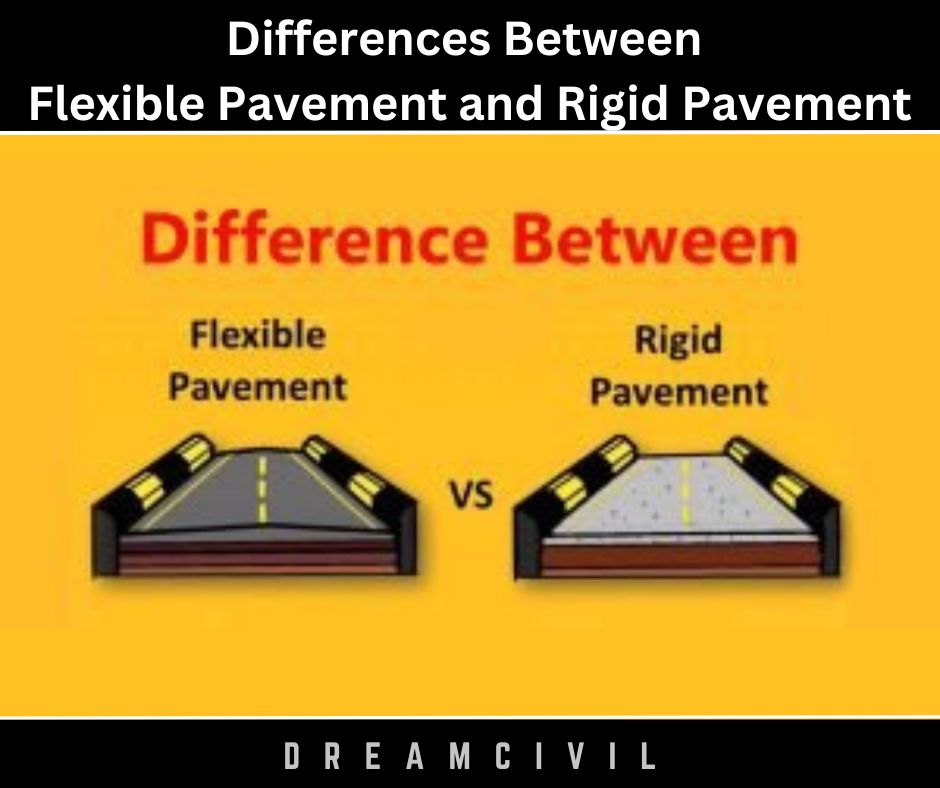Table of Contents
✔ In this article, we will discuss 23 differences between flexible pavement and rigid pavement.
✔ The verb “pave” originated from the French word “paver,” which means to lay stone floors without gaps.
A highway pavement consists of superimposed layers of processed materials above the natural soil subgrade, whose primary function is distributing the applied vehicle loads to the subgrade. There are two types of pavement, i.e., Flexible Pavement and Rigid Pavement.
23 differences between flexible pavement and rigid pavement are given below:
A. Differences Between Flexible Pavement and Rigid Pavement
| S.N. | Flexible Pavement | Rigid Pavement |
| 1. | It transfers the wheel load to subgrade by grain-to-grain mechanism. | It transfers the wheel load to subgrade by slab action. |
| 2. | The initial construction cost is low. | The initial construction cost is high. |
| 3. | It doesn’t require joints. | It requires joints. |
| 4. | Durability is low. | Durability is high. |
| 5. | It doesn’t distribute load uniformly. So, a good subgrade is required. | It distributes wheel load uniformly. So, there is no requirement for a good subgrade. |
| 6. | There is no effect of temperature variation on stress variation. | Temperature variation affects the stress variation. |
| 7. | The lifespan of flexible pavement is approximately 10 to 15 years. | The maximum lifespan of rigid pavement is approximately 20 to 30 years or more. |
| 8. | Repair work is simple. | Repair work is complex. |
| 9. | The maintenance cost is high. | The maintenance cost is low. |
| 10. | It doesn’t require curing. | It requires curing. |
| 11. | Poor night visibility due to the use of asphalt. | Good night visibility due to the use of concrete. |
| 12. | No glare due to sunlight. (Glare: Shine with a solid or dazzling light.) | High glare due to sunlight. |
| 13. | Easy to locate and perform underground works like repairing or locating pipes. | Hard to perform underground works. |
| 14. | Its thickness is less. | Its thickness is more. |
| 15. | The bearing capacity of the subgrade influences design. | The bearing capacity of the subgrade doesn’t influence its design. |
| 16. | Aggregate and bitumen are used as the key materials. | Concrete and steel are used as key materials. |
| 17. | Stability depends upon the interlocking of aggregates, particle friction, and cohesion. | Stability depends upon joints between the slabs of concrete. |
| 18. | The settlement is permanent. It is not capable of resisting settlement. | It is capable of resisting settlements to some extent. |
| 19. | It is susceptible to heat, oils, greases, and chemicals. | It is highly resistant to heat, oil, greases, and chemicals. |
| 20. | Rolling ( Compacting ) of the surface is needed. | Rolling ( Compacting ) of the surface is not needed. |
| 21. | It has a low flexural strength. | It has high flexural strength. |
| 22. | The force of friction is less. | The force of friction is high. |
| 23. | It is more comfortable for travel. | It is less comfortable for travel. |
B. Conclusion
From the above differences, our winner is Rigid Pavement.
Rigid Pavement is beneficial because of its durability and low maintenance cost. Its durability is a double or triple-flexible pavement, making it very economical in the long run.
If you plan to construct the road on your property or surrounding, we prefer you to choose rigid pavement.
It has been found that rigid pavement can last about 60-100 years easily if the traffic is low and proper maintenance is done.
Read More: Surveyor Compass

